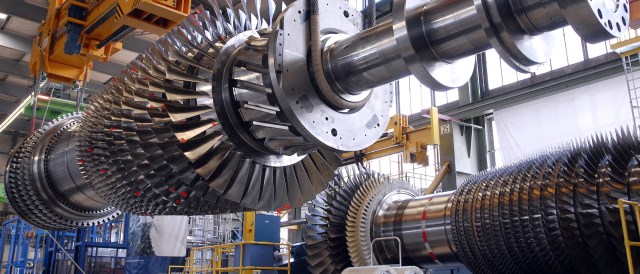The German Environmental Ministry (BMU) and German industry association BDI have produced a brochure of 22 examples of how creative German companies are striving in the green economy. Craig Morris says the publication shows how focused the German business world is on the energy transition.

A combined cycle gas turbine with over 60% net efficiency- one of the examples for how German companies (in this case Siemens) profit from the growing green economy. (Siemens Press Picture)
In May, the BMU and the BDI signed a Memorandum for a Green Economy, and the new 36-page PDF (in German) aims to show examples of best practices in a wide range of firms. A couple of household names are included – such as Siemens, Volkswagen, Robert Bosch, Bayer, and BASF – but I’ll focus on some of the more energy-intensive firms below.
Aluminum production is one of the most power-hungry industrial processes of all. Did you know that the largest aluminum rolling and casting plant in the world is in Germany? Aluminium Norf processes some 1.5 million tons per year. As the brochure explains, the rolls of aluminum used to have to be heated up to 180 degrees, then cooled down to 60 degrees, and then heated up again to 480 degrees. The firm switched to five new furnaces that can take up the aluminum rolls directly, and waste heat is recovered as well. The result is lower energy consumption – 4.9 gigawatt-hours less power and 9.8 gigawatt-hours less natural gas.
Natural gas is a big issue for such firms in Germany, some of whom (like BASF) consume so much electricity and heat that they can simply run their own gas turbine. Yet, as I explained recently, lower gas prices are not an objective of the energy transition. Germany imports almost all of its gas, the biggest supplier being Russia. Even if the country were to start exploiting shale gas (which is not going to happen), gas prices would not go down as a result because providers of shale gas would simply sell at the current market rates (one reason why it won’t happen).
Another best practice in the brochure is therefore all the more interesting. Stainless steel producer Edelstahlwerke Schmees requires a lot of heat, so it switched to an innovative ladle heating station to cut gas consumption in half.
The green economy is more than just lower energy consumption and energy efficiency. Other examples in the brochure cover environmental sustainability – lower water consumption, recycling, less pollution, and resource conservation. And as the brochure explains, the green economy – defined as environmental technology and resource efficiency – currently makes up nearly 11 percent of gross domestic product in Germany, which in turn makes up 15 percent of the global market.
But we write about the energy transition here, and the two examples discussed above show at least two things. First, that Germany is still home to lots of energy-intensive production. Second, relatively high industry energy prices in Germany over the past decade have been an incentive for firms to switch to efficiency; they have not been driven away. The reasons why they might stay include highly skilled workers, reliable power supply, and a forecast of relatively affordable industry power going forward.
Craig Morris (@PPchef) is the lead author of German Energy Transition. He directs Petite Planète and is writes every workday for Renewables International.
[…] German Energy Transition is Favorable to Business and Industry […]